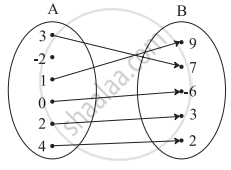Advertisements
Advertisements
Question
If \[f\left( x \right) = \frac{\sin^4 x + \cos^2 x}{\sin^2 x + \cos^4 x}\] for x ∈ R, then f (2002) =
Options
(a) 1
(b) 2
(c) 3
(d) 4
Solution
(a) 1
Given:
\[f\left( x \right) = \frac{\sin^4 x + \cos^2 x}{\sin^2 x + \cos^4 x}\] On dividing the numerator and denominator by \[\cos^4 x\]\ , we get \[f\left( x \right) = \frac{\tan^4 x + \sec^2 x}{1 + \tan^2 x \sec^2 x} = \frac{1 + \tan^4 x + \tan^2 x}{1 + \tan^2 x\left( 1 + \tan^2 x \right)} = \frac{1 + \tan^4 x + \tan^2 x}{1 + \tan^4 x + \tan^2 x} = 1\] (For every x ∈ R)
For x = 2002, we have
f (2002) = 1
APPEARS IN
RELATED QUESTIONS
Which of the following relations are functions? Give reasons. If it is a function, determine its domain and range.
- {(2, 1), (5, 1), (8, 1), (11, 1), (14, 1), (17, 1)}
- {(2, 1), (4, 2), (6, 3), (8, 4), (10, 5), (12, 6), (14, 7)}
- {(1, 3), (1, 5), (2, 5)}
Find the domain of the function f(x) = `(x^2 + 2x + 1)/(x^2 - 8x + 12)`
f, g, h are three function defined from R to R as follow:
(iii) h(x) = x2 + 1
Find the range of function.
Let X = {1, 2, 3, 4} and Y = {1, 5, 9, 11, 15, 16}
Determine which of the set are functions from X to Y.
(c) f3 = {(1, 5), (2, 9), (3, 1), (4, 5), (2, 11)}
If f(x) = (x − a)2 (x − b)2, find f(a + b).
If \[y = f\left( x \right) = \frac{ax - b}{bx - a}\] , show that x = f(y).
If f(x) = loge (1 − x) and g(x) = [x], then determine function:
(ii) fg
If f(x) = cos (log x), then the value of f(x2) f(y2) −
If f(x) = cos (log x), then the value of f(x) f(y) −\[\frac{1}{2}\left\{ f\left( \frac{x}{y} \right) + f\left( xy \right) \right\}\] is
If f(x) = cos (loge x), then \[f\left( \frac{1}{x} \right)f\left( \frac{1}{y} \right) - \frac{1}{2}\left\{ f\left( xy \right) + f\left( \frac{x}{y} \right) \right\}\] is equal to
f is a real valued function given by \[f\left( x \right) = 27 x^3 + \frac{1}{x^3}\] and α, β are roots of \[3x + \frac{1}{x} = 12\] . Then,
If f(x) = sin [π2] x + sin [−π]2 x, where [x] denotes the greatest integer less than or equal to x, then
The domain of definition of \[f\left( x \right) = \sqrt{\frac{x + 3}{\left( 2 - x \right) \left( x - 5 \right)}}\] is
The domain of definition of \[f\left( x \right) = \sqrt{x - 3 - 2\sqrt{x - 4}} - \sqrt{x - 3 + 2\sqrt{x - 4}}\] is
The range of the function \[f\left( x \right) = \frac{x}{\left| x \right|}\] is
Let \[f\left( x \right) = \sqrt{x^2 + 1}\ ] . Then, which of the following is correct?
If \[\left[ x \right]^2 - 5\left[ x \right] + 6 = 0\], where [.] denotes the greatest integer function, then
If f(m) = m2 − 3m + 1, find f(− x)
A function f is defined as follows: f(x) = 4x + 5, for −4 ≤ x < 0. Find the values of f(−1), f(−2), f(0), if they exist.
If f(x) = `{(x^2 + 3"," x ≤ 2),(5x + 7"," x > 2):},` then find f(0)
Check if the following relation is a function.

Find the domain and range of the following function.
f(x) = 7x2 + 4x − 1
Find the domain and range of the following function.
f(x) = `root(3)(x + 1)`
Express the area A of a square as a function of its side s
Let f be a subset of Z × Z defined by f = {(ab, a + b) : a, b ∈ Z}. Is f a function from Z to Z? Justify?
Check the injectivity and surjectivity of the following function.
f : R → R given by f(x) = x2
Find the domain of f(x) = log10 (x2 − 5x + 6)
Solve for x.
2 log10 x = `1 + log_10 (x + 11/10)`
Answer the following:
Show that, `log |sqrt(x^2 + 1) + x | + log | sqrt(x^2 + 1) - x|` = 0
Answer the following:
Show that, `log ("a"^2/"bc") + log ("b"^2/"ca") + log ("c"^2/"ab")` = 0
Answer the following:
Simplify `log_10 28/45 - log_10 35/324 + log_10 325/432 - log_10 13/15`
Answer the following:
If f(x) = log(1 – x), 0 ≤ x < 1 show that `"f"(1/(1 + x))` = f(1 – x) – f(– x)
Find the domain for which the functions f(x) = 2x2 – 1 and g(x) = 1 – 3x are equal.
The domain of the function f defined by f(x) = `1/sqrt(x - |x|)` is ______.
Find the domain of the following functions given by f(x) = x|x|
Find the range of the following functions given by f(x) = 1 + 3 cos2x
(Hint: –1 ≤ cos 2x ≤ 1 ⇒ –3 ≤ 3 cos 2x ≤ 3 ⇒ –2 ≤ 1 + 3cos 2x ≤ 4)
If f(x) = `log_e{((1 - x))/((1 - x))}, |x| < 1, f{(2x)/((1 + x^2))}` is equal to ______.
The ratio `(2^(log_2 1/4 a) - 3^(log_27(a^2 + 1)^3) - 2a)/(7^(4log_49a) - a - 1)` simplifies to ______.
